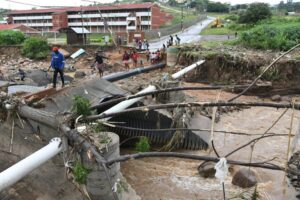Generally speaking, water management disaster scenarios in water-challenged countries such as South Africa present one of three problems: too little, too much or too dirty.
 SRK Consulting senior technologist and disaster management consultant Andries Fourie
As these events become more frequent and severe, South Africa will need to lift its game in disaster management to become more resilient. Risk assessments for water-related issues, such as flooding, drought, and water pollution, are therefore essential.
“Effective management of water-related risks involves better maintenance of infrastructure, consistently applying building regulations, maintaining stormwater systems and developing ongoing mitigation strategies,” SRK Consulting senior technologist and disaster management consultant Andries Fourie says. “Other practical measures include regularly reassessing and updating flood lines to reflect new climate realities and ensuring compliance with environmental regulations.”
He adds that it is also essential to consider both tangible impacts such as property damage, and intangible impacts like loss of income and workforce disruptions.
Varied regions, varied impact
Fourie highlights the diverse impacts of climate change across different regions of the world, emphasising the unique challenges faced by South Africa.
“Here we’re witnessing a mixed bag of climate impacts, with some areas experiencing reduced water availability while others seeing an increase,” he says. “This variability has significant implications for flood frequency and intensity.”
He warns that the mean annual damage, which estimates yearly damage over a period (such as 50 or 100 years), will likely increase as flood events become more frequent.
SRK principal scientist Herman Booysen
SRK principal scientist Herman Booysen points to the necessity for adaptive planning strategies to address shifting flood risks.
“As climate patterns evolve, we need to anticipate higher frequencies of floods and droughts, depending on the region,” says Booysen. “This means that traditional disaster management plans must develop to reflect these changing realities. “Too often, he notes, these plans overlook the changing landscape of flood risk.
“We need to adopt a more holistic approach that incorporates both engineering and non-engineering solutions,” he explains. “For example, strategically building sport fields in floodplains, taking up space and not allowing settlement in these areas. This can subtly discourage people from attempting to settle in these dangerous area.”
Technological aids
Fourie notes that technologies such as remote sensing, drones and AI are increasingly used to manage water-related risks. For instance, drones allow for real-time monitoring and assessment during disasters, rapidly surveying affected areas to provide high-resolution images and videos that help in assessing damage and planning response efforts.
“AI plays a significant role in analysing vast amounts of data collected from various sources. It can predict potential disaster scenarios by modelling different environmental factors and their interactions,” he says.
Similarly, early warning systems are critical in disaster management. Such systems rely on various technologies to monitor environmental conditions and provide timely alerts to potentially affected populations. “These often utilise Geographic Information Systems (GIS), radar and satellite imagery to track weather patterns and predict extreme events like floods and droughts,” says Booysen.
Central to disaster management is the National Disaster Management Centre. “These are dedicated individuals striving to fulfil their roles effectively, but there is a need to build the necessary expertise and a resource base to recover quickly from disaster-related damages,” he says. “This means addressing systemic issues affecting the smooth flow of information and resources, particularly at the grassroots level.”
SRK Consulting senior technologist and disaster management consultant Andries Fourie
As these events become more frequent and severe, South Africa will need to lift its game in disaster management to become more resilient. Risk assessments for water-related issues, such as flooding, drought, and water pollution, are therefore essential.
“Effective management of water-related risks involves better maintenance of infrastructure, consistently applying building regulations, maintaining stormwater systems and developing ongoing mitigation strategies,” SRK Consulting senior technologist and disaster management consultant Andries Fourie says. “Other practical measures include regularly reassessing and updating flood lines to reflect new climate realities and ensuring compliance with environmental regulations.”
He adds that it is also essential to consider both tangible impacts such as property damage, and intangible impacts like loss of income and workforce disruptions.
Varied regions, varied impact
Fourie highlights the diverse impacts of climate change across different regions of the world, emphasising the unique challenges faced by South Africa.
“Here we’re witnessing a mixed bag of climate impacts, with some areas experiencing reduced water availability while others seeing an increase,” he says. “This variability has significant implications for flood frequency and intensity.”
He warns that the mean annual damage, which estimates yearly damage over a period (such as 50 or 100 years), will likely increase as flood events become more frequent.
SRK principal scientist Herman Booysen
SRK principal scientist Herman Booysen points to the necessity for adaptive planning strategies to address shifting flood risks.
“As climate patterns evolve, we need to anticipate higher frequencies of floods and droughts, depending on the region,” says Booysen. “This means that traditional disaster management plans must develop to reflect these changing realities. “Too often, he notes, these plans overlook the changing landscape of flood risk.
“We need to adopt a more holistic approach that incorporates both engineering and non-engineering solutions,” he explains. “For example, strategically building sport fields in floodplains, taking up space and not allowing settlement in these areas. This can subtly discourage people from attempting to settle in these dangerous area.”
Technological aids
Fourie notes that technologies such as remote sensing, drones and AI are increasingly used to manage water-related risks. For instance, drones allow for real-time monitoring and assessment during disasters, rapidly surveying affected areas to provide high-resolution images and videos that help in assessing damage and planning response efforts.
“AI plays a significant role in analysing vast amounts of data collected from various sources. It can predict potential disaster scenarios by modelling different environmental factors and their interactions,” he says.
Similarly, early warning systems are critical in disaster management. Such systems rely on various technologies to monitor environmental conditions and provide timely alerts to potentially affected populations. “These often utilise Geographic Information Systems (GIS), radar and satellite imagery to track weather patterns and predict extreme events like floods and droughts,” says Booysen.
Central to disaster management is the National Disaster Management Centre. “These are dedicated individuals striving to fulfil their roles effectively, but there is a need to build the necessary expertise and a resource base to recover quickly from disaster-related damages,” he says. “This means addressing systemic issues affecting the smooth flow of information and resources, particularly at the grassroots level.”









